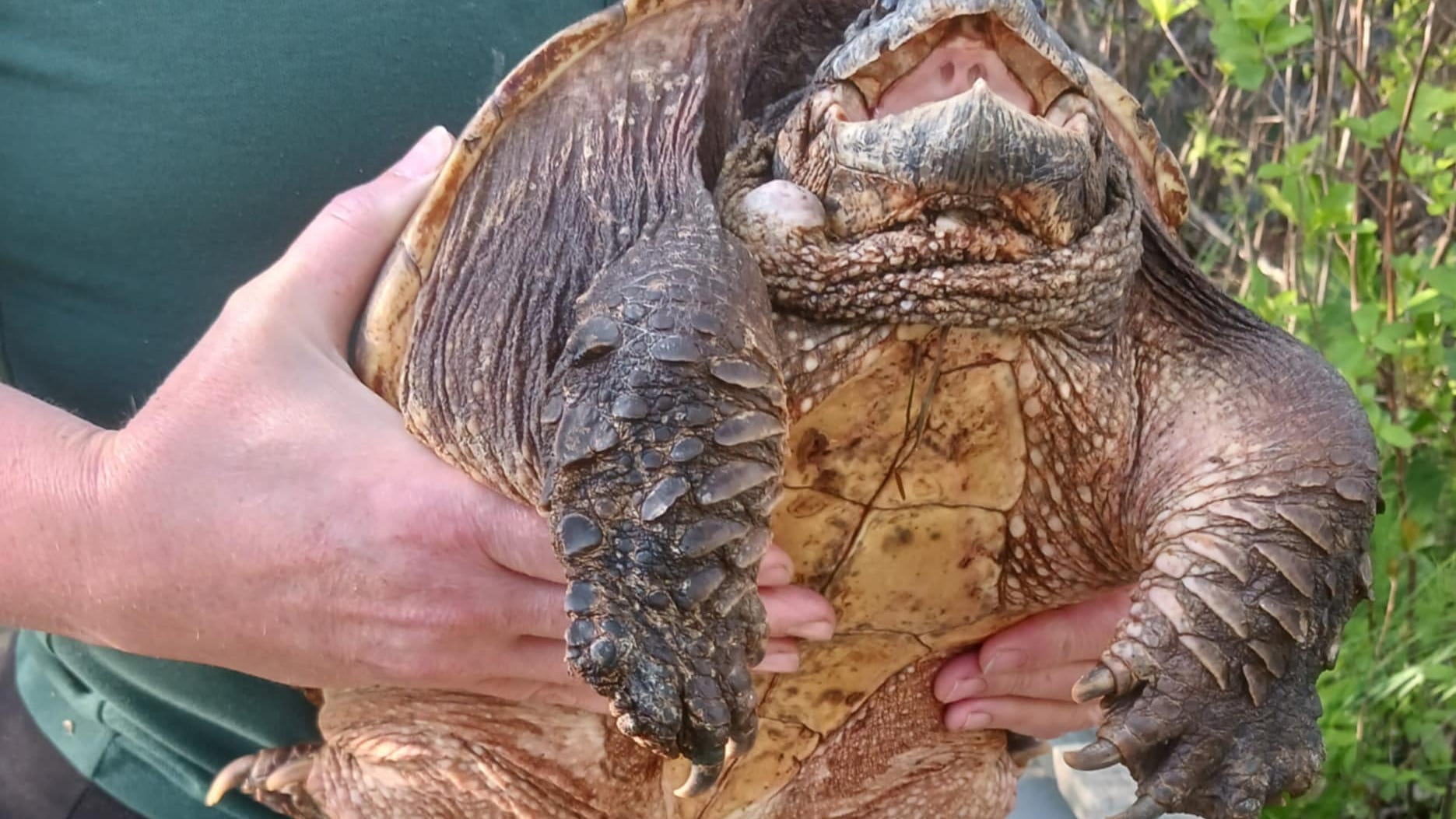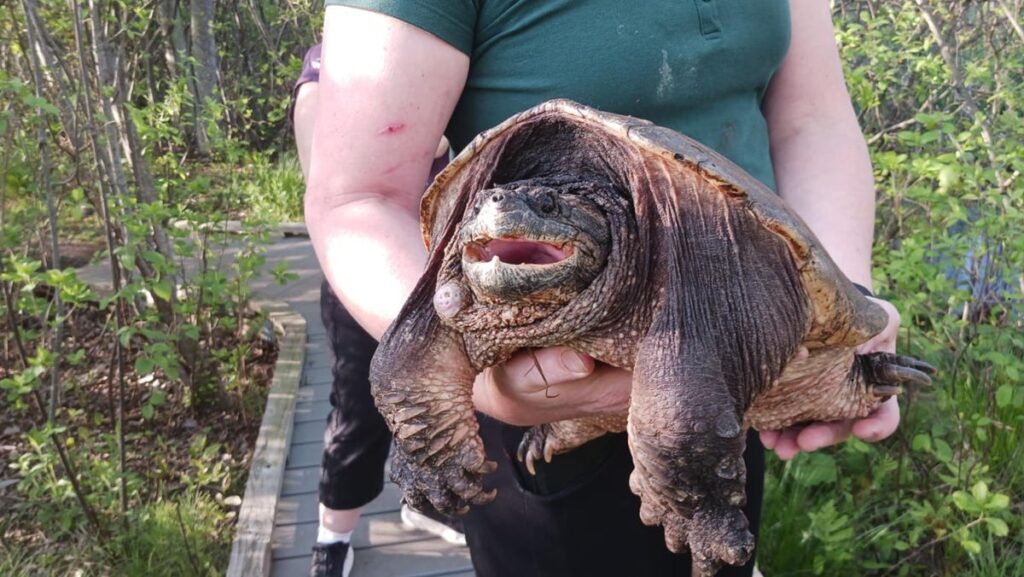Woo! Science is a column of science news and newsmakers in Worcester and the region. Got a science news idea? Email Margaret Smith at msmith@wickedlocal.com.
This column has been updated with additional information.
He’s handsome, strong and rugged, weighing in at about 27½ pounds, and measuring about 14 inches in length. Rumpus, a common snapping turtle, looks ready to take on any challenge, but like all of us, sometimes needs help from friends.
Last December, while plodding along culvert running through a brook on conservation land in Reading, Rumpus found himself, of all places, in a beaver deceiver, a large, cube-shaped cage, attached to one end of the culvert. They’re often installed as a means to manage water levels without causing harm to a beaver or destroying their dams.
Two women noticed Rumpus sputtering in confusion, and knew just who to call: the Turtle Rescue League, a Southbridge-based nonprofit dedicated to providing a haven, medical care and lots of love to turtles in need. Among other things, Rumpus needed treatment for an abscess on one side of his face.
Nowick noted that at the time, the pond Rumpus calls home had ice covering part of the surface. Rumpus exhibited some disorientation, which Nowick said signaled possible oxygen depletion. His eyes were a milky blue, Nowick said. Concerned about the possibility of an opportunistic infection. All of which meant, “He had to come back to the rescue, and spend the winter with us.”

Releasing Rumpus the snapping turtle
Natasha Nowick, president and executive director of Turtle Rescue League, holds Rumpus, a male snapping turtle, in preparation for releasing him into the waters of his home in Reading.
A balmy May evening brought light breezes through trees nearly in full leaf, dapples of sunlight, and, for the Turtle Rescue League, time to bid bon voyage to Rumpus, after a months-long convalescence.
Volunteers gathered around as Natasha Nowick, president and executive director of Turtle Rescue League, pulled the lid off a large container for a Rumpus reveal.
Hoisting him out of the container, Nowick held him up for a hail and farewell from all his friends. Being mammals, we humans will want to crowd in close for a massive group hug before seeing off someone we love. But for Rumpus, a thoroughgoing reptile of the order of Testudines, reacted with some apprehension. As a signal of unease, he began to “musk.” No, not that Musk. He began secreting a strong-smelling odor, which perhaps was his own way of saying, parting is such sweet sorrow. Or, smelly sorrow.
“Right now, he’s pretty defensive, because he feels good, he’s fully aware, and he does not like humans handling him,” Nowick said. “This is a natural instinct, I’m a giant predator, and I’m holding him up in the air, so for him, this is a bad day.”
Nowick gingerly passed Rumpus to Michaela Conder, Turtle Rescue League’s veterinary clinician, as Conder made her way to the edge of the water. Conder set Rumpus down gently at the water’s edge, and he was home at last. “He is musking so much,” Conder said. “You can see it dripping down my hand there.”
Living on ‘turtle time’
And did he paddle off in a splash of exuberance? No, he did not. With his adorable little snoot, and all his senses, he tested his surroundings, to make himself familiar with his surroundings once more. “He’s tasting the water,” Conder said.
As Nowick explained, things happen on “turtle time,” and turtle time is a long time indeed.
Turtles go back to the Triassic period, about 200 million years ago, said Michael Jones, state herpetologist with the state Division of Fisheries and Wildlife.
From a human perspective, most turtles look sweet and adorable. Traditionally, the stand-out exception has been snapping turtles, the target of unfounded fears (they’re not waiting for you to splash into a lake so they can chomp your toes) and general misunderstanding.
No matter: snapping turtles enjoy a loyal fan base, as evidenced by photos and displays of affection on social media, including that of the Turtle Rescue League, the Facebook group, Wildlife of Worcester County and Beyond, and more.
John Randell, wildlife photography enthusiast and moderator of the Wildlife of Worcester County and Beyond page, said snapping turtles have come a long way, trundling into many hearts. “It’s a funny thing, because I remember, growing up as a kid, my friends, they had a house on a lake … they wanted to catch it and kill it,” said Randell, who has photographed many snapping turtles. Randell said, “People were scared of snapping turtles.”
Randell said, “The compassion for them has definitely changed. They are actually very mellow when in the water. When out of the water, they don’t like to be handled, and stuff like that.”
But turtle nesting season approaches, many turtle species will begin risking life, limb and shell to get to their egg-laying spots.
A charismatic ‘oddball’
Massachusetts is home to 10 species of turtles, not including sea turtles in our coastal waters, said Jones. A lot of those species are closely related in family groups, but Jones said, “the snapping turtle is the only one in its family.” What’s more, the extended family of snapping turtles has a notable range. “It’s part of a turtle that goes all the way down to Mexico, Costa Rica and Ecuador, which is a really unusual distribution for a North American turtle.”
What’s more, Jones said, “There is a lot about them that is really, really cool. They are largest turtle in the state. They have a wider distribution statewide. They occur in Nantucket, Martha’s Vineyard, even the Fenway.”
It’s easy to see why snapping turtles are scene stealers. But it’s one of two turtle species in the state that Jones classes as “oddballs.” “One is the snapping turtle, and the other guy, that gets very little attention, is the musk turtle.” Both these turtles are in their own groups, without any close relatives in the state.
Snapping facts
With its primordial appearance, powerful jaws and long claws, Jones said it’s important to sort assumptions from fact when it comes to snapping turtles. “People worry about them biting under water. They really don’t,” Jones said. “I would have no concern of swimming near turtles, or kids being near them. They don’t try to bite under water. They don’t bite at toes. They don’t bite at fingers.”
Which isn’t to say that a snapping turtle wouldn’t bite at all, it it sensed a possible threat. “It’s a pretty nasty bite, but they won’t bite your fingers off,” said Jones, who said a snapping turtle bite, rare as it is, would more likely occur on land, if a person got in its way.
Although adult snapping turtles spend a majority of time in the water, females will haul themselves out, trundling to a soft, sandy place, where they deposit their eggs, from which will hatch lots of tiny snapping turtles.
When humans try to help
If you come across a snapping turtle, or any turtle, laying her eggs, Jones says, just leave it the heck alone.
What about when they’re in the middle of the road?
Helping a turtle on the road depends on a lot of factors, including judging whether it’s safe to actually go out into the road to aid the turtle. That can depend on location and the general speed of traffic.
A sweet little painted turtle or box turtle might prove fairly easy to pick up, but snapping turtles?
Don’t try to grab it by the tail or drag it, which can injure the turtle, Jones said. You may have luck putting a towel over the back of the shell, thus netting the powerful hind feet. Here’s something else to consider: an adult turtle can weigh a lot. “I’ve never had trouble simply picking them up and moving them, but you have to know where to grab them, and that is something that scares some people,” Jones said.
Picking it up with a shovel? That can have mixed results.
Whatever you do, don’t try to get the turtle to chomp on a stick or broom handle and then drag it, which can cause injuries.
And don’t put it back where it came from; it’s focused on getting to its nesting site, and will only turn around and head back out, to try again.
In search of safe passage
I’ve been writing about turtles and turtle crossings for a long time, and in that time, awareness of turtles, and their traveling season, have grown.
Has it helped? Jones thinks it has, but said, “There are turtles dying in 351 towns. It’s on the order of thousands of turtles killed on the road this time of year.”
The Department of Transportation, often called Mass DOT, and Mass Wildlife have formed partnerships in recent years, taking wildlife crossings into account when a road or bridge requires major work, such as resurfacing, or culvert replacement. That can present a good, feasible opportunity for putting measures in place to help animals, Jones said.
Those measures depend on the scope of the project and location, among other factors, of which cost is surely one. In some cases, passages underneath and protections for nesting areas may help.
“One thing I think is a promising bright spot is that Mass DOT has projects with turtles and other wildlife in mind,” Jones said. “If a culver is replaces, that is the time to change things … we have a lot of undersized culverts causing problems. So, there are a lot of benefits to improving overall structure.”
The turtle’s problems don’t end with traffic speed. Increased development in areas such as the Interstate 495 corridor can make a turtle’s trek more hazardous. What to do? “Some of this is just paying attention,” Jones said. If you drive the same commute every day, and you see turtles dead, watch for them this year.”
As for Rumpus, bringing him back home was only the right and sensible thing to do. Of course, it also means the risk that he could find himself stuck once again in the beaver deceiver. There’s no guarantees, but he does have the benefit of gaining strength in the care he’s received from the Turtle Rescue League.
Estimates on a common snapping turtle’s lifespan vary. But at the estimated age of 45, Rumpus may yet have his best years ahead of him.

